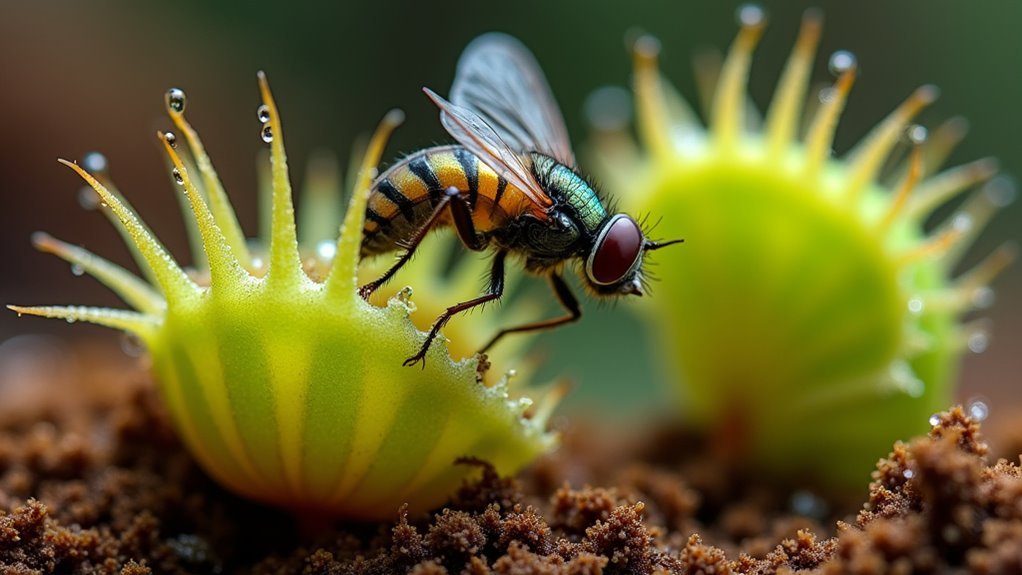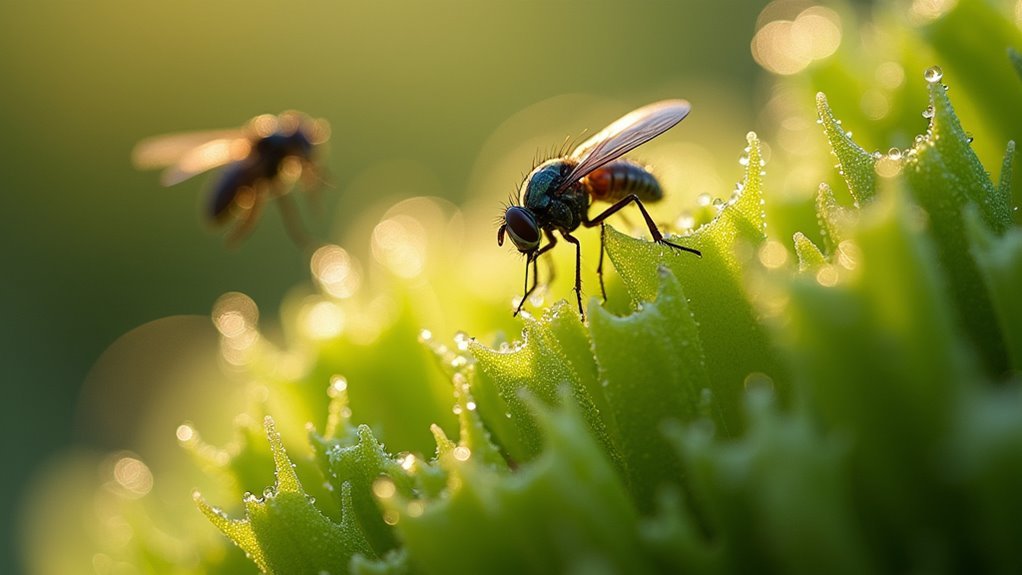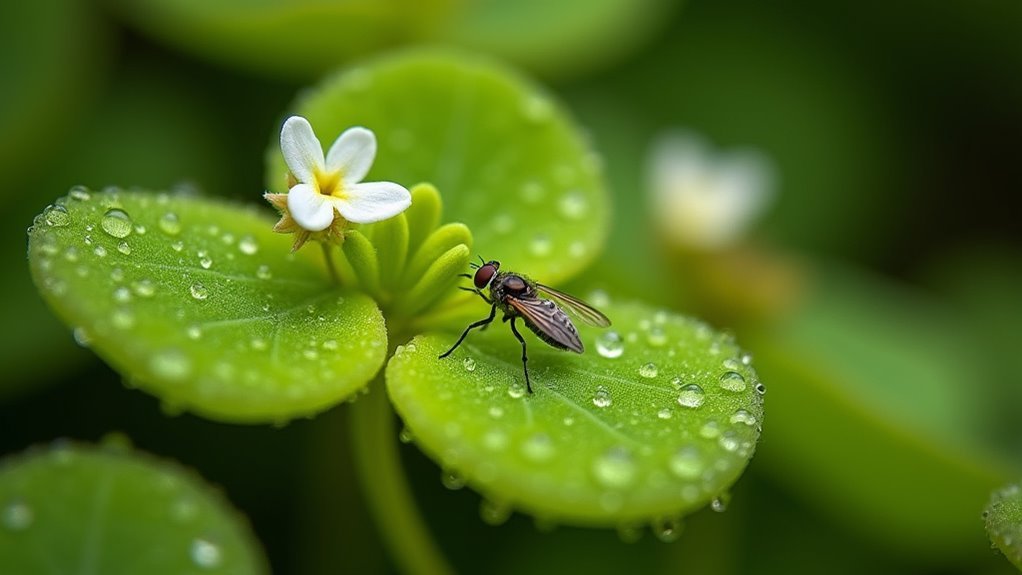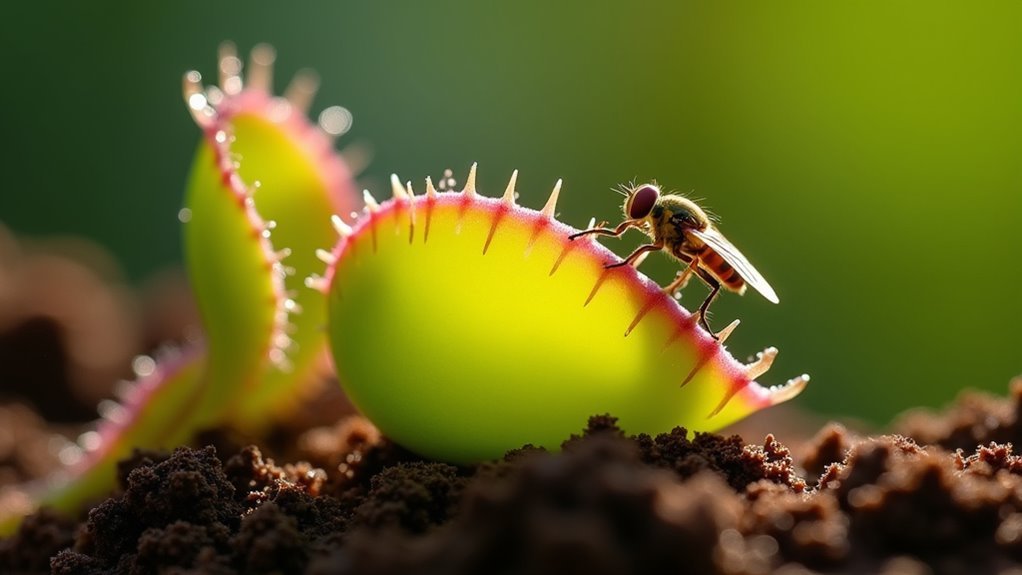You can use carnivorous plants like Venus flytraps, sundews, and pitcher plants for natural fly control. Venus flytraps snap shut on flies within milliseconds, while sundews capture prey with sticky nectar surfaces. Pitcher plants use slippery-walled traps that insects can’t escape from. Butterworts work well against small flying pests like gnats and fruit flies. These plants thrive in nutrient-poor soil with distilled water and 6-8 hours of direct sunlight. Discover the specific care requirements and setup strategies that’ll maximize their pest-catching potential.
How Carnivorous Plants Capture and Digest Flying Insects

Carnivorous plants have evolved remarkable hunting mechanisms that transform them into efficient insect-catching machines.
You’ll find Venus Flytrap uses sensitive trigger hairs that detect when flies land on its leaves, causing hinged traps to snap shut within milliseconds. The plant’s specialized cells create an airtight seal, preventing escape while digestive enzymes break down the prey.
Nature’s fastest trap springs into action when unsuspecting insects trigger the Venus Flytrap’s ultra-sensitive hairs, sealing their fate in milliseconds.
Sundews employ a different strategy – you’ll notice their leaves covered in sticky, glandular hairs that glisten like dewdrops. When flies contact these surfaces, they become trapped in the adhesive secretions. The hairs then curl around victims, further immobilizing them for digestion.
Pitcher Plants lure insects into tubular structures filled with digestive liquid. The slippery interior walls cause flies to tumble inside, where they drown and decompose over several days to weeks.
Types of Trapping Mechanisms Used by Fly-Eating Plants
You’ll find that fly-eating plants employ three distinct mechanisms to capture their prey effectively.
Each method—snap traps, sticky surfaces, and pitfall systems—targets flying insects through different strategies that guarantee successful capture and digestion.
Understanding these trapping mechanisms will help you choose the right carnivorous plants for your specific pest control needs.
Snap Trap Mechanisms
Among nature’s most dramatic hunting strategies, snap traps represent lightning-fast mechanisms that’ll capture flies before they know what hit them.
Venus Flytraps exemplify this hunting method with hinged lobes that snap shut when unsuspecting insects trigger sensitive hairs inside the trap. You’ll witness this remarkable process unfold in less than a second – faster than most flies can react.
Once closed, these trap insects become prisoners while the plant secretes powerful digestive enzymes. This breakdown process takes one to three weeks, during which the same trap can’t capture additional prey.
You’re observing a highly specialized adaptation that allows these plants to thrive in nutrient-poor soils by supplementing their diet with insect protein, making them effective natural pest controllers.
Sticky Surface Traps
While snap traps rely on lightning-fast movement, sticky surface traps take a completely different approach by creating inescapable adhesive surfaces that ensnare flies the moment they land.
You’ll find these mechanisms in sundews (Drosera), including Drosera capensis, which feature glandular hairs secreting sticky nectar on their leaves.
Butterworts (Pinguicula) use greasy, adhesive-coated leaves that trap flying insects effectively.
These sticky surface traps don’t just capture prey—they actively break down nutrients over time using digestive enzymes.
You can use sundews and butterworts indoors where flies are problematic, as they’re particularly effective against small insects.
While they’ll greatly reduce small insect populations in controlled environments, they won’t completely eliminate severe pest infestations.
Pitfall Drowning Systems
Pitfall traps operate on an entirely different principle, using gravity and drowning rather than adhesive capture.
These pitcher-shaped traps feature slippery inner walls that prevent insects from climbing out once they’ve fallen inside. You’ll find a pool of digestive fluid waiting at the bottom, where trapped flies meet their fate through drowning.
The bright, colorful openings serve as visual lures, drawing unsuspecting insects toward the trap’s entrance. Once submerged, enzymes begin breaking down the organic matter over days or weeks.
Sarracenia and Nepenthes species excel at this passive control method, requiring no maintenance while continuously capturing various flying pests.
Unlike active snap traps, these systems remain perpetually open, making them exceptionally reliable for long-term fly management in your space.
Venus Flytraps for Natural Fly Control
The Venus flytrap stands out as nature’s most recognizable carnivorous plant and offers an effective, chemical-free solution for controlling fly populations.
These remarkable venus flytraps attract bugs using sweet-scented nectar that lures flies into their hinged traps. When prey touches the sensitive trigger hairs inside, the lobes snap shut, capturing the insect for digestion over 3-12 days.
You’ll need to provide proper care for ideal pest control performance. Keep your venus flytraps in bright sunlight with distilled water, avoiding tap water contamination.
They thrive in nutrient-poor, acidic soil conditions similar to their natural bog habitats. While they’re excellent at capturing individual flies, consider them supplementary pest control rather than a complete solution for larger infestations.
Sundews and Their Sticky Trap System

Beyond snap traps, sundews offer a completely different approach to carnivorous pest control through their ingenious sticky capture system. You’ll find these plants use long leaves covered in glandular hairs that secrete sweet, nectar-like substances to lure flies and small insects. Once trapped, the sticky hairs roll over victims, securing them for digestion.
| Species | Best For | Digestion Time |
|---|---|---|
| Drosera capensis | Indoor fungus gnats | 3-5 days |
| Drosera binata | Fruit flies | 4-7 days |
| Drosera spatulata | Small flying insects | 3-6 days |
| Drosera aliciae | Mixed indoor pests | 5-8 days |
| Drosera rotundifolia | Outdoor fly control | 7-12 days |
With over 200 species available, sundews provide versatile fly control options for both indoor and outdoor environments, making them incredibly effective natural pest management solutions.
Pitcher Plants as Effective Fly Catchers
You’ll find pitcher plants excel at catching flies through their ingenious tubular traps that lure insects with bright colors, then drown them in digestive liquid once they slip past the plant’s slippery rim.
These carnivorous hunters can snag larger prey like wasps and flies more effectively than many other insectivorous plants.
However, you’ll need to provide specific humidity and sunlight conditions, making them better suited for greenhouse or outdoor growing rather than typical indoor environments.
Pitcher Plant Trap Mechanics
When you observe a pitcher plant’s hunting strategy, you’ll notice it employs one of nature’s most elegant trapping mechanisms. The tubular trap features a slippery rim that causes insects to lose their footing and tumble into the digestive liquid below. Steep walls prevent escape once prey falls inside.
| Component | Function | Result |
|---|---|---|
| Nectar | Attracts insects | Lures prey to trap opening |
| Slippery rim | Causes loss of footing | Insects fall into pitcher |
| Steep walls | Prevents climbing out | Traps prey inside |
| Digestive liquid | Drowns and breaks down prey | Provides plant nutrients |
These trap mechanics work continuously, allowing multiple captures simultaneously. Digestive enzymes dissolve the drowned insects over several days, converting them into essential nutrients that fuel the pitcher plant’s growth and survival.
Indoor Growing Requirements
Understanding these sophisticated trap mechanics helps you harness pitcher plants’ natural hunting abilities indoors for effective fly control.
These plants that can help eliminate pests thrive in high humidity environments, making them perfect for terrariums or humid rooms. You’ll need bright, indirect sunlight since direct rays scorch their leaves.
Create proper indoor growing conditions using nutrient-poor soil—mix sphagnum moss with perlite or orchid bark to replicate their bog habitat. Water regularly with distilled or rainwater, keeping soil consistently moist without complete drying.
Their colorful, nectar-producing openings and digestive fluids effectively lure flies into tubular traps. With proper care, these carnivorous plants help keep your indoor spaces naturally pest-free.
Butterworts for Small Flying Pest Management

Although butterworts (Pinguicula) might look like ordinary houseplants, they’re actually sophisticated pest control systems that’ll tackle your small flying insect problems naturally.
These carnivorous plants use sticky, glandular leaves coated with sweet substances to trap gnats, fruit flies, and other small flying pests effectively.
You’ll find butterworts particularly valuable because they thrive in nutrient-poor conditions, making them perfect for windowsills where flying insects congregate.
As a bonus, they’ll reward you with stunning spring flowers while maintaining their pest control duties.
For ideal results, plant your butterworts in sphagnum moss mixed with vermiculite or sand.
Keep the soil consistently moist through regular watering, as proper moisture levels are essential for effective insect trapping and digestion.
Care Requirements for Carnivorous Plants
Since carnivorous plants have evolved in harsh, nutrient-poor environments, they’ll thrive when you replicate these conditions rather than treating them like typical houseplants.
Your carnivorous plants need specific care to flourish and effectively control pests:
- Water Management: Use only distilled or rainwater, keeping soil moist at all times with about 3/4 inches of standing water in the tray.
- Light Exposure: Provide bright, direct sunlight for 6-8 hours daily to maintain the vibrant colors that attracts bugs.
- Soil Composition: Plant in nutrient-poor, high-peat soil mix with excellent drainage holes to prevent root rot.
Feed them occasionally with small fish flakes or dead insects to supplement their natural diet.
Avoid fertilizers completely, as these plants have adapted to extract nutrients from their prey rather than rich soil.
Limitations and Realistic Expectations for Plant-Based Pest Control
While carnivorous plants offer an intriguing natural approach to pest management, they won’t single-handedly solve your fly problem. You’ll need realistic expectations about their capabilities and limitations for effective pest control.
These plants target specific insects like flies and mosquitoes but won’t deter all pests. Environmental factors such as humidity, temperature, and proximity to attractants greatly affect their performance. You can’t simply place a few carnivorous plants and expect complete pest elimination.
Consider the coverage area and number of plants required. A small Venus flytrap won’t handle large infestations effectively.
Additionally, these plants need specific growing conditions that may not suit all indoor or garden environments. Use carnivorous plants as supplementary pest control alongside other proven methods for best results.
Frequently Asked Questions
What Is the Best Plant for Eating Flies?
You’ll find Venus Flytraps are the best for eating flies. They’re specifically designed to catch flying insects with their snap traps, using sweet nectar as bait. They’re efficient, reliable, and perfect for indoor pest control.
What’s the Best Plant to Get Rid of Flies?
You’ll want sundews for the best fly control. They’re incredibly effective at catching small flies with their sticky leaves, and they’re easier to care for than Venus flytraps while providing continuous pest management.
What Eats a Lot of Flies?
You’ll find pitcher plants consume the most flies since they’re designed to drown multiple insects simultaneously in their tubular traps filled with digestive liquid, making them extremely effective hunters.
What Is the Flower That Eats Flies?
You’re thinking of the Venus Flytrap, which uses hinged lobes to snap shut on flies after they’re lured by sweet nectar. It’s the most famous carnivorous flower that actively traps and digests insects.
In Summary
You’ll find carnivorous plants can supplement your pest control efforts, but don’t expect them to eliminate all flying insects. Venus flytraps, sundews, pitcher plants, and butterworts each offer unique trapping methods that’ll catch some flies. However, you’re looking at a natural solution that works slowly and requires specific care conditions. You’ll get better results combining these plants with other pest management strategies rather than relying on them alone.





Leave a Reply